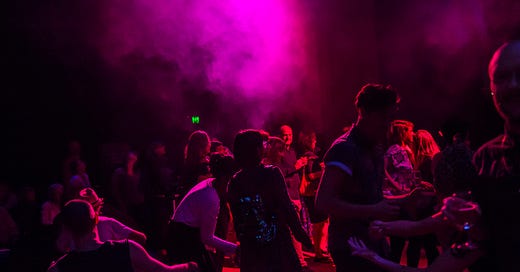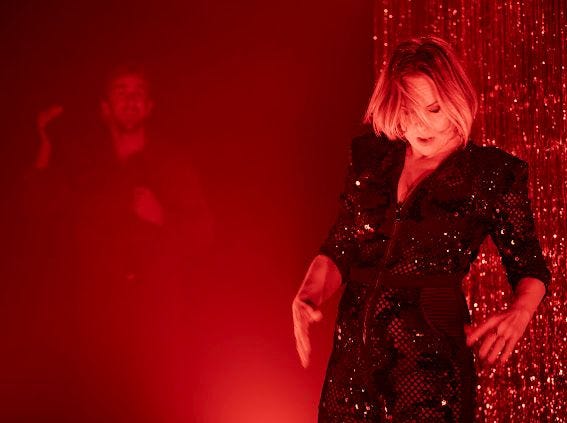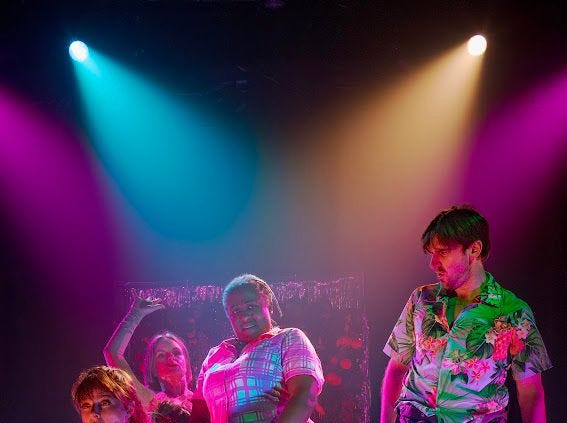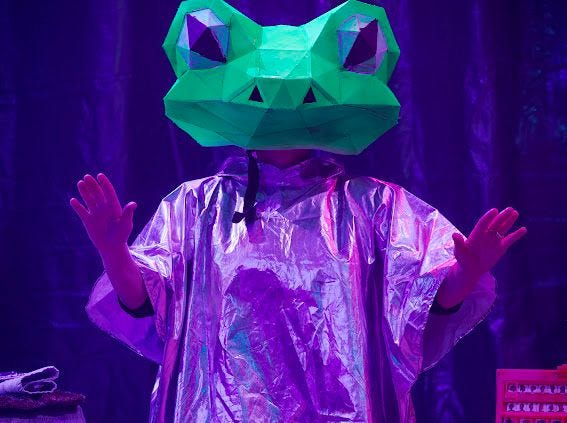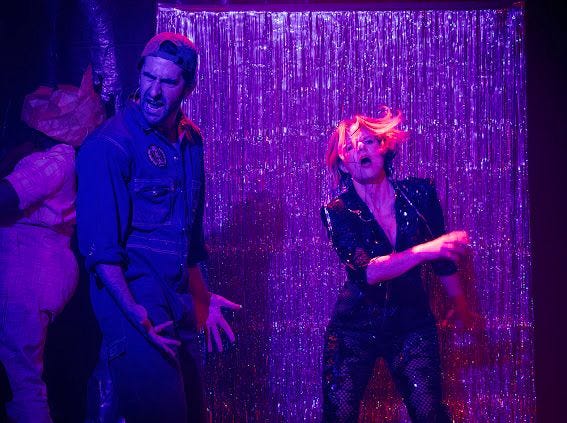For a podcast version of this newsletter, you can listen on Spotify or in your browser.
—————————————
First three things people ask about a piece of climate art:
1. Will it change people’s minds who don’t already believe in climate change?
2. Will it lead to practical solutions?
3. Will it be hopeful?
In the case of my work, the answers to these questions are usually no, no and probably not.
——
I never set out to create ‘climate art’ in the traditional sense. When Boho and I started making theatre in this space in the mid-2000s, we weren’t focused on social change or reaching across the aisle. We were a bunch of nerds discussing complex systems science, network theory and ecology. We were working with earth system researchers and exploring concepts like resilience and tipping points.
But as soon as audiences and critics connected our shows with climate change, they began asking those three questions: ‘Will it change minds? Will it lead to political action? Is it hopeful?’ It crept into the shows whether we wanted it to or not.
Before long, we found ourselves being marketed as eco-artists or climate activsts. Theatre marketing departments started including the words ‘hopeful’ or ‘inspiring’ in the blurbs for our shows. Interviewers started asking us for advice about reducing your carbon footprint, or how our work might change the minds of climate deniers.
——
To begin with, I didn’t mind being framed this way. It’s not like we didn’t want to change people’s minds or make the world a better place. If people really felt our brand of wonky science theatre could have that impact, great!
So I started making work that more consciously fit that ‘climate art’ category. I set out to create theatre that could connect with climate skeptics, that could inspire people to take action, that could nurture feelings of hope and optimism. Some of these shows, in their limited way, even achieved those goals.
But something about this work never felt quite right to me. And I couldn’t put my finger on it, but over the years, that feeling of discomfort gradually grew.
——
What I noticed was that audiences who came to ‘climate art’ shows shared some very particular qualities:
1. There weren’t very many of them
2. They possessed a kind of earnest guilt.
The energy of these crowds reminded me of that puritanical impulse in some religions, the part of the self that wants to excoriate itself with shame and self-anger.
These audiences wanted to be told that (a) we’re fucked, and (b) it’s our fault. When I said those things, or some variant of them, they leaned in and nodded. Those moments were when you felt the energy crackle in the room. For this crowd, that was the equivalent of playing the hits.
But those moments were never the point of the show for me, and I increasingly felt out of sync with what that audience wanted.
I don’t want to act ungrateful. I was putting on interactive science-theatre about climate and complex systems in the late 2000s, I was in no position to be picky. I was (and am) grateful to anyone who showed up. (If you’re out there and you came to a performance of Sun Drugs or True Logic of the Future, bless you.) But after a while I started to feel like I’d signed up by accident to give a sermon in a harsh evangelical church for an audience that wanted very badly to be damned.
——
That started to shift for me when I wrote Kill Climate Deniers. The KCD script came at a very particular moment for me. I was exhausted and frustrated with seeing the scientists I worked with being attacked by tedious dullards, cowards and time-wasters. Instead of trying to say the right things to convince people or win them over, I let go and vented all my unproductive feelings. I said all the things I knew I shouldn’t say. I had fun.
It took a minute, but when that show connected, it really connected. And my favourite part of it, once it started to build up a following, was that people weren’t coming to Kill Climate Deniers to be told about how bad the world is or what we should do about it. They came for the exact same reasons people came to see the 50 Shades of Grey movies: to see what the fuss was about. To be part of a conversation. To have a fun night.
I’m not going to claim any grand epiphanies from that experience, but I will say that it’s much more fun to be bracketed alongside 50 Shades of Grey than An Inconvenient Truth.
Maybe unsurprisingly, the audiences and critics who engaged with climate art were pretty mixed on Kill Climate Deniers. It wasn’t changing anyone’s mind. It didn’t offer practical solutions. It wasn’t particularly hopeful. Judged by the standard climate art criteria, it was a failure.
But… it was interesting. It was a fun night out. On those metrics, the show was perhaps the successful thing I’d ever written. Better yet, no-one asked me for my advice regarding their carbon footprint.
———
So I let go of trying to make good climate art. I stopped trying to reach any particular audience, I gave up trying to make people feel any particular way or encourage them to take any particular action.
At this point in my arts practice, I follow my curiosity. I write about the things that fascinate me. And it happens that the moment we’re living through is utterly fascinating.
I’m overwhelmed and delighted and terrified and angry and awestruck and obsessed with the things that are taking place around us, within us, the ways our world and our lives are transforming. I want to understand them, I want to share them, I want to discuss them. I don’t have any solutions. I’m not a scientist, I’m not an activist, I’m not even a journalist. I’m just fascinated, that’s my only qualification.
So I’ve made peace with the fact that my art and writing will have no political or social impact whatsoever. I’m following my own nose, writing about things that interest and excite me (which happens to be climate), and trusting audiences to follow that excitement and curiosity. I’m not trying to change the world, I’m trying to make a fun night out.
Part of the reason I’m comfortable with this is that I’ve learned how hard it is to make a fun night out. Did I really believe I could conjure up a specific set of feelings and political responses in an audience? That I could change peoples’ minds or lifestyles? Bloody hell, I’m not Sergei Eisenstein.
What I can do, with great effort and frequent missteps, is make a show that I might like to see. A show that is fun and playful and that includes some interesting stuff about the world. A show that’s more entertaining than spending a night in. That seems unambitious, but believe me, it’s very hard! But if you can pull it off, it’s worth it.
And weirdly, my experience is that if you give up on trying to make work that’s hopeful, audiences are more likely to find hope in it. I don’t know why. Maybe because the feeling of forced cheer that pervades self-consciously ‘hopeful’ climate art has a tinge of desperation about it. Maybe it’s because there are so few opportunities in our lives to actually confront the scale of the changes the planet is going through, any art that bluntly faces the situation head on is actually kind of a relief. But since I gave up on being hopeful, I’ve had far more audiences tell me they found some hope or respite in my work.
——
The other reason I’m happy to let go of any expectation of political impact in my work is that I’ve shifted my sense of political agency outside of my arts practice. These days, I focus my political energy on more direct actions - writing letters to politicians, donating to and volunteering with organisations, attending protests, etc. I work (by myself or as part of Boho) with different NGOs and organisations as a consultant around disaster risk and climate communication. In these settings, the sense of impact is real and tangible.
Getting more involved in direct political action freed my art from the obligation to have a political impact. And letting go of the expectation that my art would have a political impact forced me to actually take real meaningful political action, rather than pretending it was happening in my art.
——
Of course, just because I’m not interested in changing people’s minds, effecting political change or engendering hope in my writing, that doesn’t stop people from reading and interpreting my work through that lens. Any art that explicitly mentions climate change (which mine does, constantly) is going to be read as a work of climate art.
At this stage in history, these three questions are the lens through which climate art is read. When you apply that lens to my work, more often than not, it fails.
And that’s fine! You have to trust the audience to interpret a work of art how they will, and not get too hung up on what they bring to it or take from it. They’re intelligent human beings, every one of them, and I trust them to take from the work what there is to take from it.
Truth is, I’m secretly glad whenever I read a review that says ‘I don’t think this play will change anyone’s mind,’ or, ‘I don’t see any practical solutions here,’ or, ‘Finnigan doesn’t leave us on a hopeful note.’ Just because a work fails to meet the standards we apply to climate art doesn’t mean it’s any good - but I do believe that failing those standards is the first sign that a work of art might be interesting.
-—————
NEWS AND PROJECTS
44 Sex Acts In One Week
The incredible humans at Club House Productions are currently on tour at the Brisbane Comedy Festival with my disgraceful romantic comedy 44 Sex Acts In One Week. This is the show that Time Out called ‘brilliantly horny and unhinged,’ which is a glorious pull quote.
Some of my all-time favourite artists are behind it: producer/performer Bec Massey, director Sheridan Harbridge, designer Trent Suidgeest and a superb cast and crew. The show is heading to Edinburgh Fringe in August, I’m buzzed about it. These pics!
RECOMMENDATIONS
Tyson Yunkaporta - Right Story Wrong Story
I’m a big fan of Yunkaporta - Sand Talk was an extraordinary text. It didn’t rewire my brain so much as pull some wires loose that shouldn’t have been wired in the first place. Right Story Wrong Story is in some ways an even more fascinating text. Yunkaporta writes about Indigenous thinking, but he’s very carefully avoids offering a bundle of First Nations nuggets of wisdom that can be co-opted and taken out of context. Instead, this is very much an exercise of using Indigenous practice to think through problems. It’s not necessarily an easy read, but I found it incredibly rewarding.
Francis Spufford - Cahokia Jazz
I’m obviously in the sweet spot for genre novels set in alternate histories where First Nations successfully resisted colonisation (see also Laurent Binet’s Civilisations and Kim Stanley Robinson’s Years of Rice and Salt), and this one has the added bonus of being set in the 1920s with a jazz-pianist detective who used to play with Jellyroll Morton. I’m all in on this one, no reservations.
Jellyroll Morton - Doctor Jazz
Which reminded me to go back to some old favourites from that era - this song is an all-time banger, recorded I think in 1926.
Oval - Do While
Speaking of all-timers - I was frayed at the end of a long day last week, and just settled in for 24 minutes of placid glitch from 1994. So pure, so gentle. Dig.
---
As ever, you can get more background on my practice in my New Rules for Modelling series, or you can check out my website. And if you have any questions or offers that might make my life more interesting, feel free to get in touch.
Peace!

